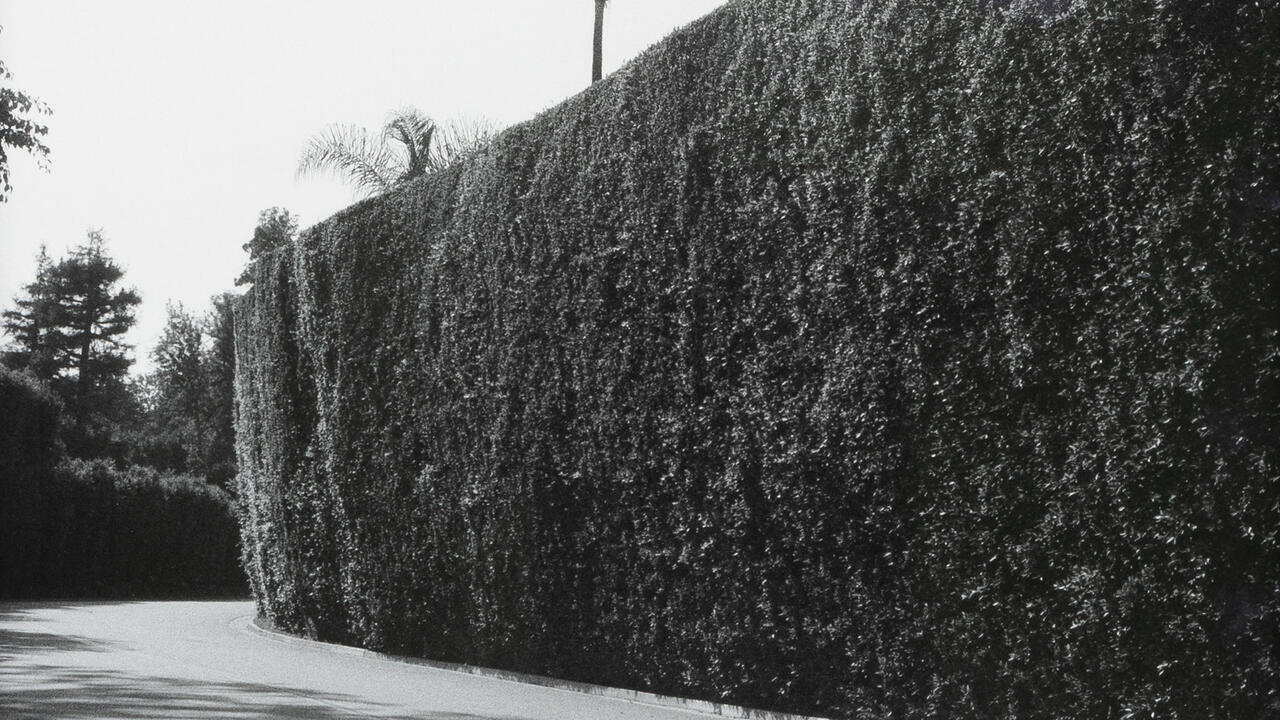Gary Simmons
Gary Simmons, who comes out of the same Cal Arts background that produced many of the 90s most interesting artists, is known for his slick, pointed, accusatory visual structures that sometimes reach the point of combativeness, sometimes step neatly past it into a play on the spectator's senses and often inexplicably combine the two.
Simmons' latest show features one extravagantly large structure, Sound Garden (Sound Drawing from the Gardens of Faded Markings) (1995), that takes up the gallery's entire front room, and three paintings in the downstairs space of the gallery that complement Sound Garden as much as they elucidate its operation. Sound Garden is a 16 inch high, 15 foot square platform of wood squares that recreates a section of a gymnasium floor, or a high-finish dance floor. The parquet is framed by a three foot wide planter of white pansies in full bloom. Suspended above the platform, in the manner of a public address system, are four out-sized black speakers. The speakers emit a three-phase, four-track audio component of verbal instructions for dance routines, the bouncing of a basketball on the floor of the gymnasium, tap dancing and the swiping of an eraser on a blackboard. The work thus takes the form of a rather peculiar hybrid structure with visual, auditory and olfactory dimensions.
As in previous works, Sound Garden employs clichéd models of African-American male success in certain sectors of the entertainment industry, addressing notions of athletic heroics, celebrity, wealth and glamour that are the fantasy of a wide range of young men. Tap dancing and playing basketball are two of the ways that young African-Americans have risen to positions of enormous visibility in the 20th century, including exposure to a large white audience; presumably one of the things signified by the border of pansies around the platform.
Sound Garden follows the techniques of industrial manufacture that are a legacy of Minimal art. The work takes up the redefinition of viewer participation that characterises Minimal works but, in as much as Simmons inserts mass cultural subject matter into a Minimal structure, Sound Garden goes beyond the rigorous reductivist aesthetic of Minimalism to link up with American Pop art. In particular, Sound Garden engages in a dialogue with Andy Warhol's Dance Diagrams of 1961-62 that emphatically preclude moments of intuition and creativity, thereby implying that claims for a genuine expressiveness are no longer tenable. Just as Warhol parodied suggestions of unmediated expression, Sound Garden engages with theories of ideology which argue that subjectivity itself is utterly dependent upon the capacity to recognise oneself within the pre-established forms of communication, belief systems and exchange that advanced capitalist society provides. If Sound Garden pays homage to men who have accomplished a great deal, it alludes at the same time to the social conditions that determine why young African-American men are disproportionately represented in athletics and dancing, yet so absent in others. It cynically implies that there is a racist discourse underlying, in fact buttressing, the success of these figures, naturalising their physical stamina, agility and rhythm. This is where Simmons gives the screw a twist: by relaying a sense of the arduous training process and enormous amount of choreography that is needed to perfect a performance, Sound Garden explodes the essentialist myth that these talents are inherent to people of African descent.
But Simmons' work reintroduces intrigue, accident and spontaneity which are, of course, the opposite of the tone set by Warhol's work as much as that of the Minimalists. This becomes particularly evident in the paintings exhibited along with Sound Garden. These are fairly large canvases, six foot square, on which diagrams from dance instruction booklets are reproduced. Shoe prints, dotted directional lines and arrows are heavily drawn in charcoal and swiped in an erasure that defaces the background and partially covers over the screened images of stars, stairs and tasselled pillows. The paintings' titles are metaphorically descriptive as in Supa Star (1995), with its sweeping charcoal lines and footprints spaced far apart across a star-studded field, or Cinderella's Big Score (1995), with its complex directional lines that map out the 'foot work', and a rectangle that signifies a basketball hoop target. The paintings explicitly respond to the question of expressivity and success through performance that is introduced in Sound Garden, though with an utter declaration of bankruptcy towards any claims that this is a form of natural expression. The return of the dance diagrams to the vertical plane, the reconstitution of risk, chance, and gesturality through Simmons' swiping action just as much as the reaffirmation of high production values that Minimalism began to dismantle inextricably links the work not to the legacy of Minimalism and Pop but to the 'return to order' of the 80s.
Indeed, in contrast to the imaginative and combative power of some of Simmons' earlier pieces, such as Mr Klanman, a concrete icon of a Ku Klux Klan member posed in the manner of a lawn jockey, or Garden of Hate, an installation exhibited at New York's Whitney Museum in 1992 which reconstructed the public square of a small American town with an azalea arrangement at its centre in the shape of a Klan cross, Sound Garden is so sensual, and the puns so weak, that whatever critique the work articulates floats to the surface. Even the procedural operation of the work is more stunning than enlightening. Filtered through the bass end of the boom-box speakers, the sounds of the dance instructor, the dribbling of a basketball, the shuffling of tap dancing shoes and the sound of an eraser swiping a blackboard are more euphonious than cacophonous. Even the twirl of a whistle sounds as if it's coming from the other end of a gymnasium and barely registers in the visitor's ears. One finds that the most combative or distancing aspect of the exhibit is the level of street noise in SoHo which often disturbs erases the phantasmagoria of sound coming out of the speakers. Such is the fate of a critical art that loses its teeth.
















